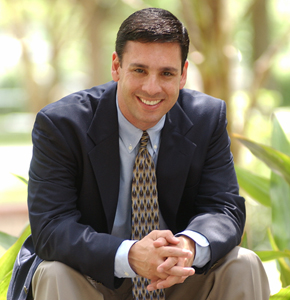
Michael Berson
IWitness has gone through many changes since Michael Berson and his doctoral education students were among the first to pilot it three years ago. But for Berson, IWitness remains one of the most valuable tools for engaging students with testimony and teaching them about the Holocaust and other topics.
Berson, a professor of social science education at the University of South Florida, first met staff of the USC Shoah Foundation while attending the Yad Vashem Conference on Holocaust Education, when IWitness was still being developed. In 2011, the team working on IWitness invited Berson and the doctoral students in his Technological Innovation in Social Studies course to spend the semester learning how to use IWitness and providing feedback on its challenges, benefits and potential for classroom use.
The students were all full-time classroom teachers – including one, Brandon Haas, who was so impressed by the website that he began working as one of the USC Shoah Foundation’s regional consultants shortly thereafter, leading educator trainings about IWitness around the country.
Berson said their class discussions mostly revolved around the questions of ethics that IWitness’s use of survivor testimony brought up. Was it ethical to allow students and teachers to edit survivor testimonies to construct their own videos and activities?
Ultimately, they decided the value of exposing students to testimony was too great to not utilize IWitness. The Visual History Archive was too large and complex for middle- and high school students to use, so IWitness would provide age-appropriate access to the testimonies. And, teachers can set guidelines for their students and teach them the concept of ethical editing.
“We stepped back and said that if a student uses a story [in IWitness] to talk about bullying, or an excerpt from testimony to talk about racism and injustice in their own community or to better understand the issue of eugenics, in the modern day world those are powerful mechanisms, and the question of ethics really fell on the side of the teacher. The teacher had to be prepared to tell that story and how to use [testimony],” Berson said.
To ensure that students understand the context of the testimonies they watch and the importance of honoring the integrity of what survivors say, Berson encourages teachers to always show IWitness’s “Ethical Editing” tutorial video to their class before they assign any activities.
Today, Berson continues to introduce educators and scholars to IWitness and the Visual History Archive (USF is a Visual History Archive access site), and he even incorporated it into USF’s first-ever course about teaching the Holocaust this past spring – IWitness was a “cornerstone” of the entire course.
He said IWitness has become more user-friendly and streamlined since the early days, but the basic principles are the same. It is still one of the best interactive tools to get students connected to history and their own world, he said.
“We’re striving to create this empathetic connection in students. Understanding a deeper, higher-level connection to a historical event, the people who were in an event, and having students deeply watch and engage with testimony and think about how to construct a story once they’ve watched it, is really a pinnacle of learning,” Berson said. “That’s why I’m so passionate about it.”